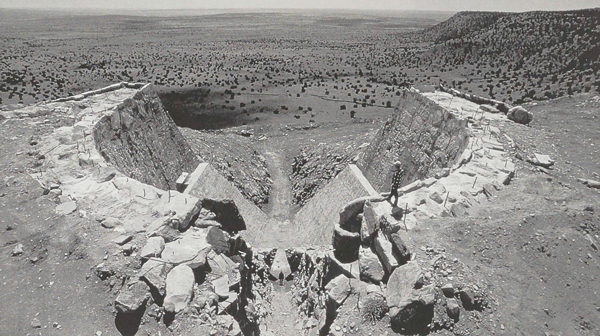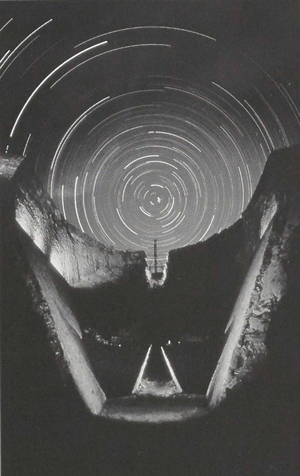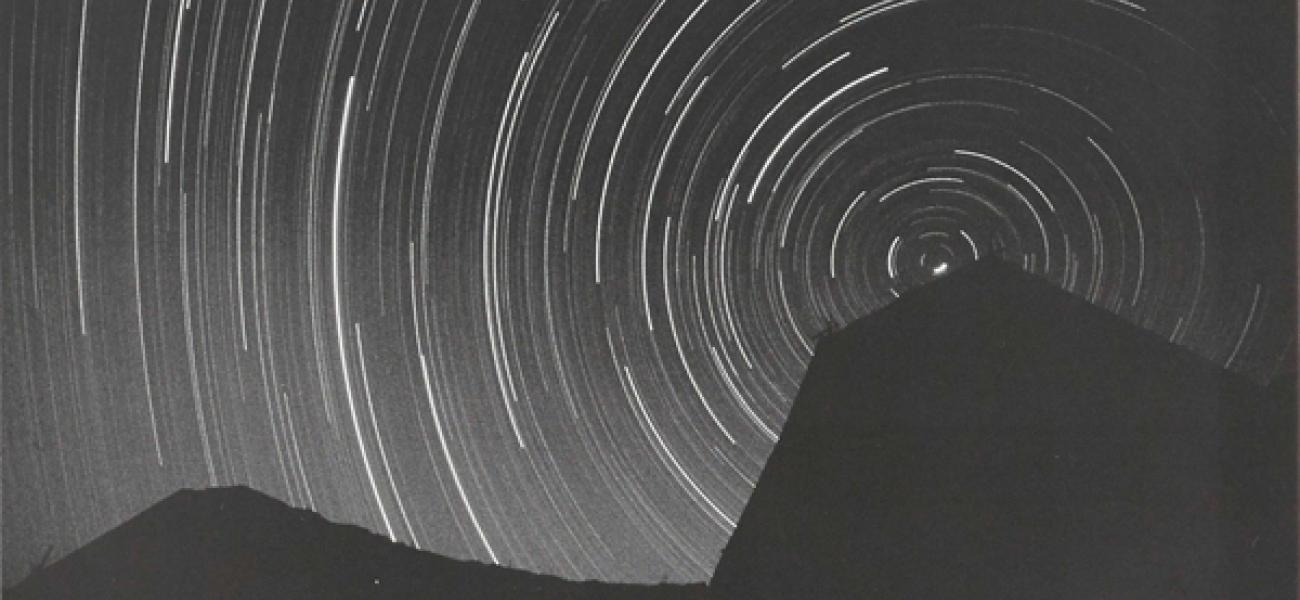Star Axis: A Theater in the Sky by Charles Ross

In the Sangre de Cristo Mountains in eastern New Mexico, an inverted con carved eleven stories through the capstone of a mesa and lined with rock focuses its eye on the celestial pole and frames the motions of the star Polaris. Inside a tunnel, placed exactly parallel to the Earth’s axis, stairs rise to the top of the 76-foot-deep crater and open onto the mesa along the spine of a 52-foot-tall pink granite pyramid whose shape is calculated from the seasonal angles of the Sun. When the work of art is finished, it will be a visual expression of mankind's connection to the stars, affirming our integration with the cosmos.
Charles Ross, a New York sculptor, has worked on his Star Axis since 1971, the year he began an intensive search in the Southwest for exactly the right site to build an ambitious work of art. He kept returning to the mesas, his internal response heightened by standing on this extraordinary boundary between Earth and Sky where an ocean of light stretched toward the Earth's distant curvature. In 1975 he purchased four hundred acres of land eighty miles southeast of Santa Fe, and construction of the project began. A five-mile dirt road was cut up the adjacent mesa and test holes bored through the capstone. The project proceeded slowly as local laborers worked on scaffolds and smoothed out ruts in the massive stone walls. Three more years of labor are expected before the sculpture is finished.
Charles Ross has always focused on light and astronomy. His art is concerned with the discovery and materialization of forms and structures contained in light. His projects include star map paintings, arrays of giant prisms mounted on skylights, prism columns and walls, each work offering a point of reference to the matrix of light. In 1993 he was commissioned by the French Ministry of Culture to create a series of Solar Burns, portraits drawn by the Sun itself. To execute these images, Ross placed a wooden plank under a large magnifying lens which, as the sun passed across the sky, burned its mark into the wood, the image being modified by passing clouds or cloudy days. The double-spiral created by these burns represented a solar hieroglyph. Ross believes that art is a window through which to view the larger natural order.
All of this kept leading Ross into the geometry of precession — the changing star alignment created by the dance of the spinning Earth. Star Axis came into being when it dawned on him that a monumental work might be created to reveal both the past and future star alignments in the 26,000 year cycle. A star maps out the human visual field in a course of its changing relationship to the planet. The North Star Polaris describes a minuscule, dime size circle in the sky now but will, in 13,000 years, encompass our entire field of vision. Through dates carved on each stair in the tunnel, visitors to Star Axis will be able to stand in the orbit of Polaris as it existed for Nefertiti, or for Confucius, or for Leonardo da Vinci. We will be able to see into the Stone Age as easily as into the future.
Charles Ross speaks of our relationship with the cosmos with casual familiarity. "My art," he says, "has shown me that it is possible for us to become aware of our intimacy with the stars. We are, after all, made of star stuff. Light is the agent of our contact with atoms and galaxies. The light that scientists study to gain a measure of the universe is the same light that falls on our skins....I've come to realize that we contain a cellular memory of our personal connection with the cosmos."
Art must work, but also works must be art. "For what matters," he concludes, "is art that opens up consciousness, awareness, makes connections, plugs people into some kind of vision about our individual interaction with the cosmos."
Charles Ross has a degree in mathematics as well as in sculpture from the University of California, Berkeley. He has had one-person exhibitions at the Museum of Contemporary Art, Chicago; Museum of Contemporary Art, La Jolla, Hayden Gallery, MIT, Cambridge; the Institute of Contemporary Art, Philadelphia; the Sena Gallery, Santa Fe. He can be reached at the Humphrey Gallery, P.O. Box 1358, Canal Street Station, New York, NY 10013.
Editor's note: This article was written by SP's founding editor, Gerry Williams. The contact information here is from the original print issue, which may or may not be valid today.

